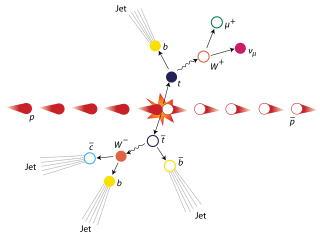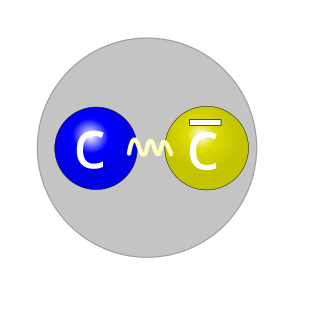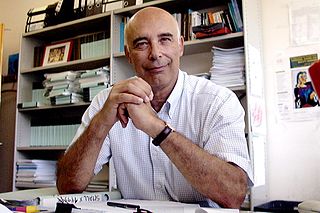
Luciano Maiani (born 16 July 1941, [1] in Rome) is a Sammarinese physicist best known for his prediction of the charm quark with Sheldon Glashow and John Iliopoulos (the "GIM mechanism"). [2]

Luciano Maiani (born 16 July 1941, [1] in Rome) is a Sammarinese physicist best known for his prediction of the charm quark with Sheldon Glashow and John Iliopoulos (the "GIM mechanism"). [2]
In 1964 Luciano Maiani received his degree in physics and he became a research associate at the Istituto Superiore di Sanità in Italy. [3] During that same year he collaborated with Raoul Gatto's theoretical physics group at the University of Florence. [3] He crossed the Atlantic in 1969 to do a post-doctoral fellowship at Harvard's Lyman Laboratory of Physics. [3] In 1976 Maiani became a professor of theoretical physics at the University of Rome, [3] however he traveled widely during this period, holding visiting professorships at the Ecole Normale Supérieure of Paris (1977) [3] and CERN (1979–1980 and 1985–1986). [3] Maiani also took an interest in the direction of particle physics research start on CERN's Scientific Policy Committee from 1984 to 1991. [3] Then, in 1993, he became president of Italy's Istituto Nazionale di Fisica Nucleare (INFN). [3] From 1993 to 1996 Maiani served as a scientific delegate in CERN council and then as that council's president in 1997. [3] Thereafter he became director general of CERN, serving from 1 January 1999 [4] through the end of 2003. [5] From 1995 to 1997 Maiani chaired the Italian Comitato Tecnico Scientifico, Fondo Ricerca Applicata. At the end of 2007 he was proposed as president of Consiglio Nazionale delle Ricerche, but his nomination was suspended temporally after he signed a letter criticizing the rector of 'La Sapienza' University in Rome, who invited Pope Benedict XVI to give a lectio magistralis in 2008. [6] However he became the President of CNR since 2008.
Luciano Maiani has authored over 100 scientific publications on the theory of elementary particles often with several co-authors. In 1970 he predicted the charmed quark in a paper with Glashow and Iliopoulos which was later discovered at SLAC and Brookhaven in 1974 and led to a Nobel Prize in Physics for the discoverers. Working with Guido Altarelli in 1974 they explained that the observed octet enhancement in weak non-leptonic decays was due to a leading gluon exchange effect in quantum chromodynamics. They later extended this effect to describe the weak non-leptonic decays of charm and bottom quarks as well and also produced a parton model description of heavy flavor weak decays. In 1976 Maiani analyzed the CP violation in the six-quark theory and predicted the very small electric dipole moment of the neutron. In the 1980s he started using the numerical simulation of lattice QCD and this led to the first prediction of the decay constant of pseudoscalar charmed mesons and of B mesons. A proponent of supersymmetry, Maiani once said that the search for it was "primary goal of modern particle physics". [7] He has not confined his interest to the theoretical side of physics either, with involvement in ALPI, EUROBALL, DAFNE, VIRGO and the LHC.
As of September 2020, he is a member of the Italian Aspen Institute. [8]

In particle physics, a hadron is a composite subatomic particle made of two or more quarks held together by the strong interaction. They are analogous to molecules, which are held together by the electric force. Most of the mass of ordinary matter comes from two hadrons: the proton and the neutron, while most of the mass of the protons and neutrons is in turn due to the binding energy of their constituent quarks, due to the strong force.

A quark is a type of elementary particle and a fundamental constituent of matter. Quarks combine to form composite particles called hadrons, the most stable of which are protons and neutrons, the components of atomic nuclei. All commonly observable matter is composed of up quarks, down quarks and electrons. Owing to a phenomenon known as color confinement, quarks are never found in isolation; they can be found only within hadrons, which include baryons and mesons, or in quark–gluon plasmas. For this reason, much of what is known about quarks has been drawn from observations of hadrons.
A timeline of atomic and subatomic physics.

The charm quark, charmed quark, or c quark is an elementary particle found in composite subatomic particles called hadrons such as the J/psi meson and the charmed baryons created in particle accelerator collisions. Several bosons, including the W and Z bosons and the Higgs boson, can decay into charm quarks. All charm quarks carry charm, a quantum number. This second generation particle is the third-most-massive quark with a mass of 1.27±0.02 GeV/c2 as measured in 2022 and a charge of +2/3 e.

The top quark, sometimes also referred to as the truth quark, is the most massive of all observed elementary particles. It derives its mass from its coupling to the Higgs Boson. This coupling is very close to unity; in the Standard Model of particle physics, it is the largest (strongest) coupling at the scale of the weak interactions and above. The top quark was discovered in 1995 by the CDF and DØ experiments at Fermilab.

The
J/ψ
(J/psi) meson is a subatomic particle, a flavor-neutral meson consisting of a charm quark and a charm antiquark. Mesons formed by a bound state of a charm quark and a charm anti-quark are generally known as "charmonium" or psions. The
J/ψ
is the most common form of charmonium, due to its spin of 1 and its low rest mass. The
J/ψ
has a rest mass of 3.0969 GeV/c2, just above that of the
η
c, and a mean lifetime of 7.2×10−21 s. This lifetime was about a thousand times longer than expected.

The LHCb experiment is a particle physics detector experiment collecting data at the Large Hadron Collider at CERN. LHCb is a specialized b-physics experiment, designed primarily to measure the parameters of CP violation in the interactions of b-hadrons. Such studies can help to explain the matter-antimatter asymmetry of the Universe. The detector is also able to perform measurements of production cross sections, exotic hadron spectroscopy, charm physics and electroweak physics in the forward region. The LHCb collaborators, who built, operate and analyse data from the experiment, are composed of approximately 1650 people from 98 scientific institutes, representing 22 countries. Vincenzo Vagnoni succeeded on July 1, 2023 as spokesperson for the collaboration from Chris Parkes. The experiment is located at point 8 on the LHC tunnel close to Ferney-Voltaire, France just over the border from Geneva. The (small) MoEDAL experiment shares the same cavern.
In particle physics, flavour or flavor refers to the species of an elementary particle. The Standard Model counts six flavours of quarks and six flavours of leptons. They are conventionally parameterized with flavour quantum numbers that are assigned to all subatomic particles. They can also be described by some of the family symmetries proposed for the quark-lepton generations.

Benjamin Whisoh Lee, or Ben Lee, was a Korean-American theoretical physicist. His work in theoretical particle physics exerted great influence on the development of the standard model in the late 20th century, especially on the renormalization of the electro-weak model and gauge theory.
Howard Mason Georgi III is an American theoretical physicist and the Mallinckrodt Professor of Physics and Harvard College Professor at Harvard University. He is also director of undergraduate studies in physics. He was co-master and then faculty dean of Leverett House with his wife, Ann Blake Georgi, from 1998 to 2018. His early work was in Grand Unification and gauge coupling unification within SU(5) and SO(10) groups.

Nicola Cabibbo was an Italian physicist, best known for his work on the weak interaction.
The timeline of particle physics lists the sequence of particle physics theories and discoveries in chronological order. The most modern developments follow the scientific development of the discipline of particle physics.

John (Jean) Iliopoulos is a Greek physicist. He is the first person to present the Standard Model of particle physics in a single report. He is best known for his prediction of the charm quark with Sheldon Glashow and Luciano Maiani. Iliopoulos is also known for demonstrating the cancellation of anomalies in the Standard model. He is further known for the Fayet-Iliopoulos D-term formula, which was introduced in 1974. He is currently an honorary member of Laboratory of theoretical physics of École Normale Supérieure, Paris.

Mikhail "Misha" Arkadyevich Shifman is a theoretical physicist, formerly at the Institute for Theoretical and Experimental Physics, Moscow, currently Ida Cohen Fine Professor of Theoretical Physics, William I. Fine Theoretical Physics Institute, University of Minnesota.

Mary Katharine Gaillard is an American theoretical physicist. Her focus is on particle physics. She is a professor of the graduate school at the University of California, Berkeley, a member of the Berkeley Center for Theoretical Physics, and visiting scientist at the Lawrence Berkeley National Laboratory. She was Berkeley's first tenured female physicist.

In particle physics, the GIM mechanism is the mechanism through which flavour-changing neutral currents (FCNCs) are suppressed in loop diagrams. It also explains why weak interactions that change strangeness by 2 are suppressed, while those that change strangeness by 1 are allowed, but only in charged current interactions.
Lev Borisovich Okun was a Soviet theoretical physicist. He is known for his contributions to particle physics and quantum chromodynamics. He coined the term hadron.
Susumu Okubo was a Japanese theoretical physicist at the University of Rochester. Ōkubo worked primarily on elementary particle physics. He is famous for the Gell-Mann–Okubo mass formula for mesons and baryons in the quark model; this formula correctly predicts the relations of masses of the members of SU(3) multiplets in terms of hypercharge and isotopic spin. Ōkubo died in July 2015.

Guido Altarelli was an Italian theoretical physicist.
Bryan Ronald Webber, FRS, FInstP is a British physicist and academic. He was a Fellow of Emmanuel College, Cambridge from 1973 to 2010, and Professor of Theoretical Physics at the University of Cambridge from 1999 to 2010. He has been awarded the Dirac Medal by the Institute of Physics, the Sakurai Prize by the American Physical Society and the High Energy and Particle Physics Prize by the European Physical Society.
{{cite web}}: CS1 maint: unfit URL (link){{cite web}}: CS1 maint: unfit URL (link){{cite web}}: CS1 maint: unfit URL (link){{cite web}}: CS1 maint: unfit URL (link)